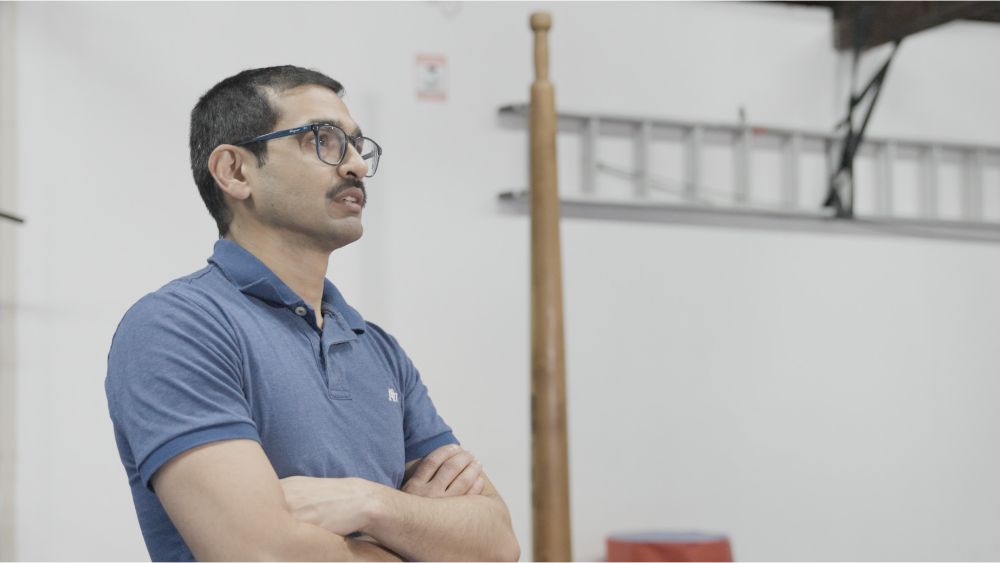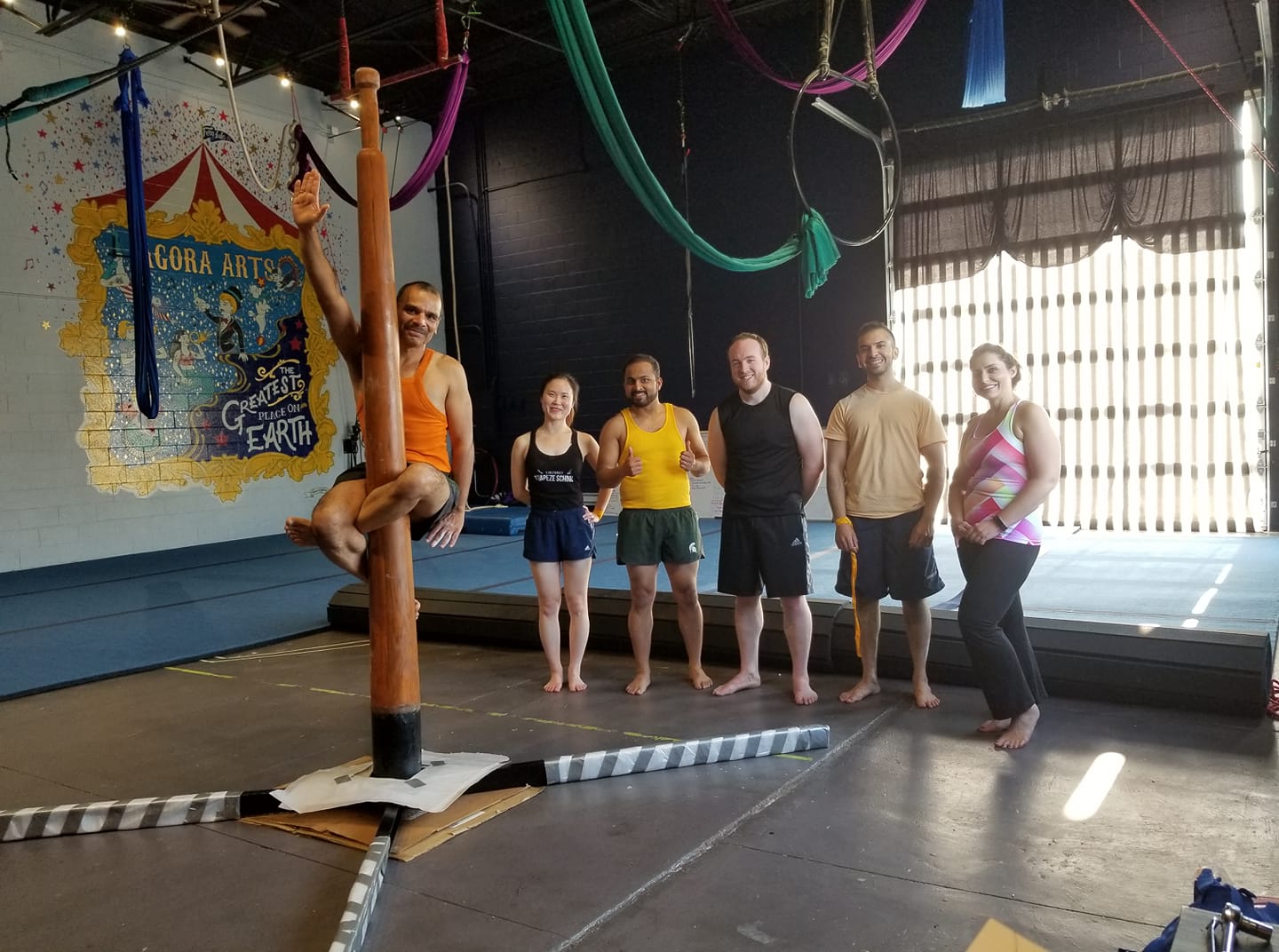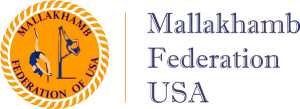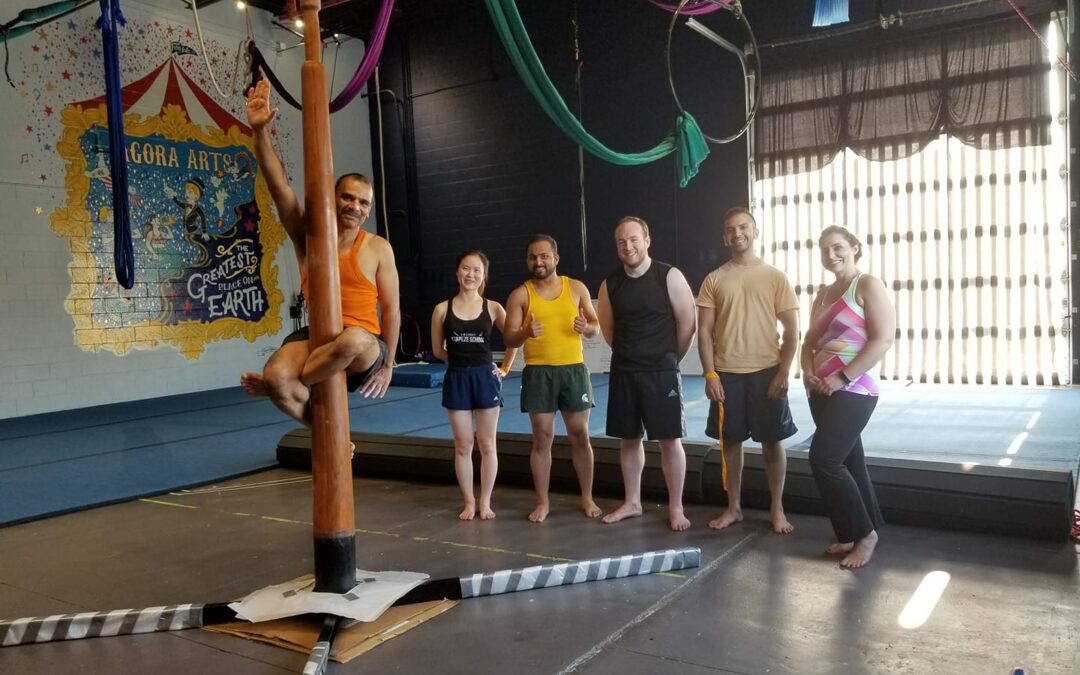Calisthenics, the art of using your body weight for resistance, has found a remarkable ally in Mallakhamb – a traditional Indian exercise form. If you wish to learn effective ways to perform muscles strengthen exercises without the need of any fancy gym equipment, Mallakhamb is the answer.
In this article, we’ll find out five Mallakhamb exercises designed for calisthenics beginners, focusing on simplicity, accessibility, and muscle engagement. We’ll especially look Mallakhamb exercise role for strengthening muscles for Calisthenics.
1. Mallakhamb Pull-Ups
Pull-ups are a classic exercise that targets multiple muscle groups, and when combined with Mallakhamb exercises for Calisthenics, they become even more dynamic.
How to Perform the Mallakhamb Exercise
- Grip the Mallakhamb pole with both hands, ensuring a comfortable distance between them.
- Hang from the pole, allowing your arms to fully extend.
- Engage your Mallakhamb core workout for Calisthenics and pull yourself up towards the pole, bringing your chest as close as possible.
- Lower yourself back down with control.
Muscles Targeted for Calisthenics Practitioner
- Back muscles: Engaged during the pulling motion.
- Biceps: Activated when pulling yourself up.
- Core muscles: Work to stabilize your body.
Benefits for Calisthenics Practitioner
- Increased upper body strength: Pull-ups with Mallakhamb provide a challenging yet effective way to build strength in your back and arms.
- Improved grip strength: Holding onto the pole requires a strong grip, contributing to enhanced overall grip strength.
2. Mallakhamb Leg Raises
Leg raises are fantastic for targeting your lower abdominal muscles, and Mallakhamb exercises for Calisthenics adds an extra layer of complexity.
How to Perform Mallakhamb Exercise
- Hang from the Mallakhamb pole with both hands.
- Lift your legs towards your chest, keeping them straight.
- Lower your legs back down in a controlled manner.
Muscles Targeted for Calisthenics Practitioner
- Lower abdominal muscles: Worked extensively during the leg lift.
- Hip flexors: Activated during the lifting motion.
- Core muscles: Engaged for stability.
Benefits for Calisthenics Practitioner
- Strengthened core: Leg raises on Mallakhamb provide an effective way to build a strong and stable core workout for Calisthenics.
- Improved hip flexibility: The dynamic leg movement enhances flexibility in the hip flexor Mallakhamb muscles strengthen exercises.
3. Mallakhamb Push-Ups
Push-ups are a staple in any calisthenics routine, and Mallakhamb push-ups add a unique twist.
How to Perform Mallakhamb Exercise
- Place your hands on the Mallakhamb pole, slightly wider than shoulder-width apart.
- Extend your legs behind you, forming a plank position.
- Lower your chest towards the pole by bending your elbows.
- Push back up to the starting position.
Muscles Targeted for Calisthenics Practitioner
- Chest muscles: Worked during the pushing motion.
- Shoulders: Activated for stability.
- Triceps: Engaged during the pushing phase.
Benefits for Calisthenics Practitioner
- Full upper body workout: Mallakhamb push-ups engage various upper body muscles simultaneously.
- Enhanced stability: The instability of the pole requires additional core workout engagement for stability.
4. Mallakhamb Squats
Squats are fundamental for lower body strength, and Mallakhamb squats provide a unique variation.
How to Perform Mallakhamb Exercise
- Stand facing the Mallakhamb pole, holding it with both hands.
- Lower your body into a squat position, keeping your knees behind your toes.
- Push through your heels to return to the starting position.
Muscles Targeted for Calisthenics Practitioner
- Quadriceps: Worked during the upward phase of the squat.
- Hamstrings: Activated as you lower your body.
- Glutes: Engaged for hip extension.
Benefits for Calisthenics Practitioner
- Stronger lower body: Mallakhamb squats target the major muscles strengthen exercises of the legs for comprehensive strength.
- Improved balance: The pole provides support, allowing beginners to focus on maintaining proper form.
5. Mallakhamb Planks
Planks are excellent for building core strength, and Mallakhamb planks add an extra challenge.
How to Perform Mallakhamb Exercise
- Place your forearms on the Mallakhamb pole, parallel to each other.
- Extend your legs behind you, forming a straight line from head to heels.
- Hold the position, engaging your Mallakhamb core workout for Calisthenics and maintaining a neutral spine.
Muscles Targeted for Calisthenics Practitioner
- Core muscles: Worked throughout the duration of the plank.
- Shoulders: Activated for stability.
- Back muscles: Engaged to maintain a straight body.
Benefits for Calisthenics Practitioner
- Core stability: Mallakhamb planks provide a stable platform to strengthen the entire core.
- Improved shoulder strength: The plank position engages the shoulders, contributing to overall upper body strength.
Conclusion
Incorporating Mallakhamb exercises into your calisthenics routine introduces a unique blend of tradition and effectiveness. These five Mallakhamb exercises cater to beginners, offering a gradual progression towards building strength and muscle endurance.
Whether you’re aiming for a full-body workout or targeting specific muscle groups, Mallakhamb proves to be a versatile and accessible tool for calisthenics enthusiasts. So, grab the Mallakhamb pole and embark on a journey of strength, flexibility, and cultural connection through these impactful Mallakhamb Core Exercises for Calisthenics.
FAQ’s
1. What are the key benefits of practicing Mallakhamb exercises for calisthenics?
Mallakhamb exercises, rooted in traditional Indian gymnastics, provide a unique blend of strength, flexibility, and balance. Engaging in these exercises enhances overall physical fitness and mental focus.
2. How many Mallakhamb exercises are typically included in a calisthenics routine?
While the number may vary, a standard calisthenics routine incorporating Mallakhamb often includes five key exercises designed to target various muscle groups and improve overall body strength.
3. Is calisthenics considered a form of muscular strength exercise?
Yes, calisthenics is indeed a form of muscular strength exercise. It utilizes body weight as resistance, requiring muscles to work against that resistance, thereby enhancing strength and endurance.
4. What distinguishes Mallakhamb exercises from other calisthenics routines?
Mallakhamb exercises are unique to Indian gymnastics and involve the use of a vertical pole or rope for bodyweight movements. These exercises combine strength, flexibility, and agility in a distinct and challenging manner.
5. Can one effectively build muscle using calisthenics, including Mallakhamb exercises?
Absolutely! Calisthenics, including Mallakhamb, is known for promoting muscle hypertrophy and strength gains. By progressively challenging the body with different exercises and variations, individuals can build and sculpt muscles effectively.
6. What type of strength training does calisthenics provide?
Calisthenics primarily offers bodyweight resistance training, promoting functional strength. It engages multiple muscle groups simultaneously, enhancing overall strength, coordination, and control.



